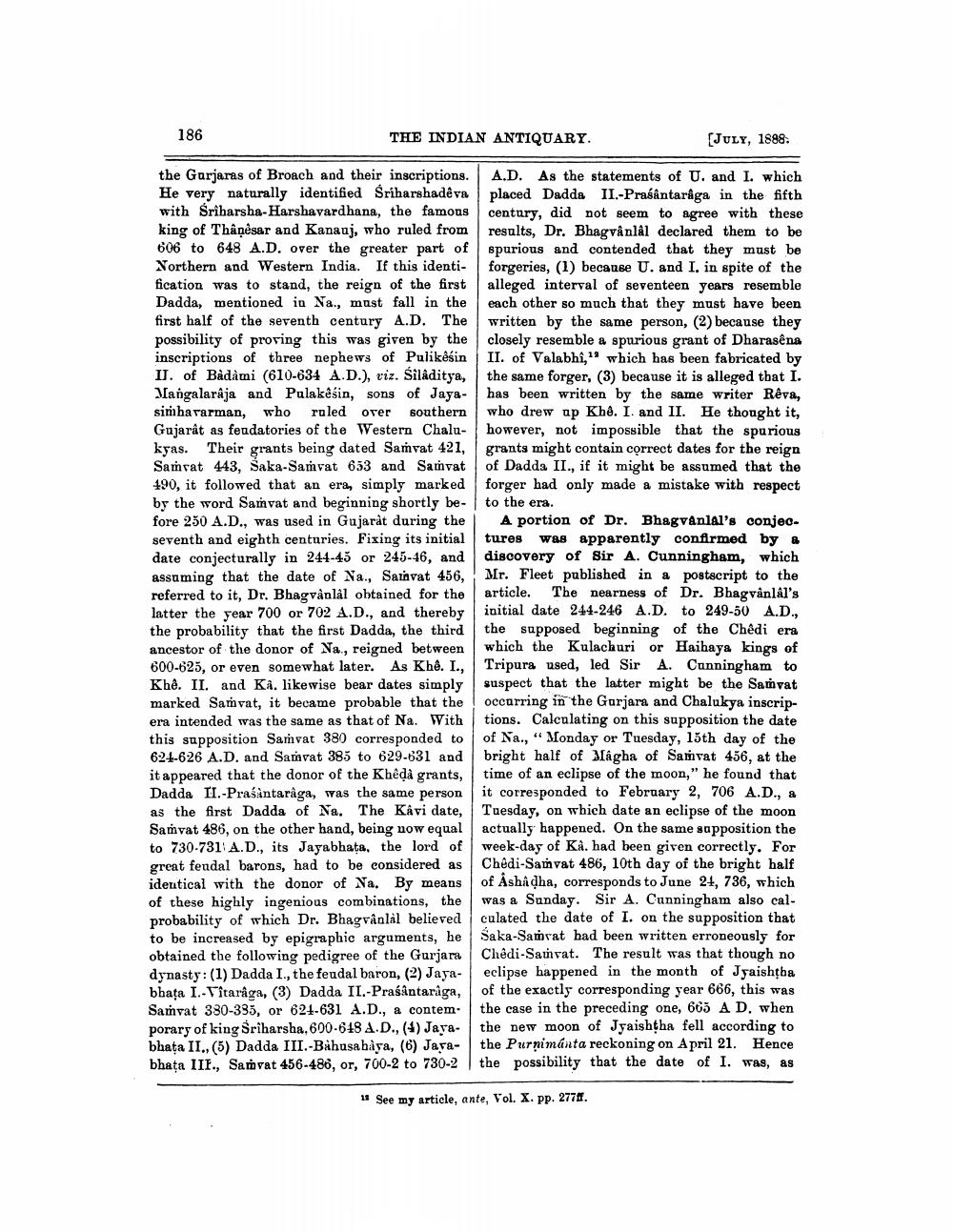________________
186
THE INDIAN ANTIQUARY.
(JULY, 1888.
the Garjaras of Broach and their inscriptions. A.D. As the statements of U. and I. which He very naturally identified Sriharshadeva placed Dadda II.-Prasantaråga in the fifth with Sriharsha-Harshavardhana, the famous century, did not seem to agree with these king of Thâņèsar and Kanauj, who ruled from results, Dr. Bhagvånlál declared them to be 606 to 648 A.D. over the greater part of spurious and contended that they must be Northern and Western India. If this identi- forgeries, (1) because U. and I. in spite of the fication was to stand, the reign of the first alleged interval of seventeen years resemble Dadda, mentioned in Na., must fall in the each other so much that they must have been first half of the seventh century A.D. The written by the same person, (2) because they possibility of proving this was given by the closely resemble a spurious grant of Dharasena inscriptions of three nephews of Pulikesin II. of Valabhi," which has been fabricated by IJ. of Badami (610-634 A.D.), viz. Siladitya, the same forger, (3) because it is alleged that I. Mangalarâja and Palakësin, sons of Jaya- has been written by the same writer Rêva, simhararman, who ruled over southern who drew ap Khê. I and II. He thought it, Gujarat as feudatories of the Western Chalu- however, not impossible that the spurious kyas. Their grants being dated Samvat 421, grants might contain correct dates for the reign Samrat 443, Saka-Samrat 653 and Samvat of Dadda II., if it might be assumed that the 490, it followed that an era, simply marked forger had only made a mistake with respect by the word Samvat and beginning shortly be to the era. fore 250 A.D., was used in Gujarat during the A portion of Dr. Bhagvanlal's conjec. seventh and eighth centuries. Fixing its initial tures was apparently confirmed by a date conjecturally in 244-45 or 245-46, and discovery of Sir A. Cunningham, which assuming that the date of Na., Sainvat 456, Mr. Fleet published in a postscript to the referred to it, Dr. Bhagvånlål obtained for the article. The nearness of Dr. Bhagvånlal's latter the year 700 or 702 A.D., and thereby initial date 244-246 A.D. to 249-50 A.D., the probability that the first Dadda, the third the supposed beginning of the Chedi era ancestor of the donor of Na., reigned between which the Kulachuri or Haihaya kings of 600-625, or even somewhat later. As Khê. I., Tripura used, led Sir A. Cunningham to Khê. II. and Kå. likewise bear dates simply suspect that the latter might be the Samvat marked Samvat, it became probable that the occurring in the Garjara and Chalukya inscripera intended was the same as that of Na. With tions. Calculating on this supposition the date this supposition Samvat 380 corresponded to of Na., “Monday or Tuesday, 15th day of the 624-626 A.D. and Saravat 385 to 629-631 and bright half of Magha of Samvat 456, at the it appeared that the donor of the Khedà grants, time of an eclipse of the moon," he found that Dadda II.-Prasantarâga, was the same personit corresponded to February 2, 706 A.D., a as the first Dadda of Na. The Kåvi date, Tuesday, on which date an eclipse of the moon Samvat 486, on the other hand, being now equal actually happened. On the same supposition the to 730-731 A.D., its Jayabhata, the lord of week-day of Kà. had been given correctly. For great feudal barons, had to be considered as Chedi-Samvat 486, 10th day of the bright half identical with the donor of Na. By means of Asha dha, corresponds to June 24, 736, which of these highly ingenious combinations, the was a Sunday. Sir A. Cunningham also calprobability of which Dr. Bhagvânlal believed culated the date of I. on the supposition that to be increased by epigraphic arguments, he Saka-Samrat had been written erroneously for obtained the following pedigree of the Gurjara Chedi-Saírat. The result was that though no dynasty: (1) Dadda I., the feudal baron, (2) Jaya- eclipse happened in the month of Jyaishta bhata I. Vitaraga, (3) Dadda II.-Prasantaraga, of the exactly corresponding year 666, this was Samvat 380-335, or 621-631 A.D., a contem. the case in the preceding one, 665 AD, when porary of king Sriharsha, 600-618 A.D., (4) Jaya- the new moon of Jyaishtha fell according to bhata II., (5) Dadda III.-Bahusabaya, (6) Java- the Purnimánta reckoning on April 21. Hence bhata IIF., Samvat 456-486, or, 700-2 to 730-2 | the possibility that the date of I. was, as
1 See my article, ante, Vol. X. pp. 277ff.




